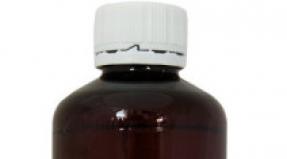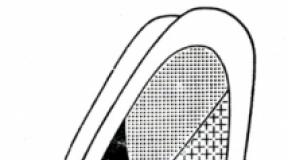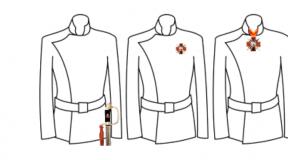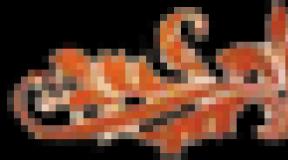Isoprinosine composition is detailed. What Isoprinosine tablets help from - instructions. Method of administration and dosage
Registration certificate: P N015167 / 01 - 110210
P N015167 / 01-110210
Trade name of the drug:Isoprinosine
International non-proprietary name:
Inosine pranobex &Chemical name:Inosine (hypoxanthine-riboside): para-acetylaminobenzoic acid (acidoben): M, M-dimethylamino-2-propanol (dimepranol) \u003d 1: 3: 3 complex
Dosage form:
pillsComposition:
one tablet contains:Active substance:Inosine Pranobex (Isoprinosine) - 500 mg
Excipients:mannitol, wheat starch, povidone, magnesium stearate.
Description
Oblong biconvex tablets of white or almost white color with a slight amine odor, with a score on one side.
Pharmacotherapeutic group:
immunostimulating agent.The code ATX : J05AX05
Pharmacological properties
Isoprinosine is a synthetic complex derivative of purine with immunostimulating activity and nonspecific antiviral action. Restores the functions of lymphocytes under conditions of immunosuppression, increases blastogenesis in the population of monocytic cells, stimulates the expression of membrane receptors on the surface of T-helpers, prevents a decrease in the activity of lymphocytic cells under the influence of glucocorticosteroids, and normalizes the inclusion of thymidine in them. Isoprinosine has a stimulating effect on activity cytotoxic T lymphocytes and natural killer cells, the function of T-suppressors and T-helpers, increases the production of immunoglobulin (Ig) G, interferon-gamma, interleukins (IL) -1 and IL-2, reduces the formation proinflammatory cytokines - IL-4 and IL-10, potentiates the chemotaxis of neutrophils, monocytes and macrophages. The drug exhibits antiviral activity in vivo against Herpes simplex viruses, cytomegalovirus and measles virus, human T-cell lymphoma virus type III, polioviruses, influenza A and B, ECHO virus (human enterocytopathogenic virus), encephalomyocarditis and equine encephalitis. The mechanism of the antiviral action of Isoprinosine is associated with inhibition of viral RNA and the enzyme dihydropteroate synthetase, which is involved in the replication of some viruses, enhances the synthesis of mRNA of lymphocytes suppressed by viruses, which is accompanied by suppression of viral RNA biosynthesis and translation of viral proteins, increases the production of interferons-alpha by lymphocytes with antiviral properties. When combined, it enhances the effect of interferon-alpha, antiviral agents acyclovir and zidovudine.
Pharmacokinetics
After oral administration, the drug is well absorbed from gastrointestinal tract... The maximum concentration of ingredients in blood plasma is determined after 1-2 hours.
It is rapidly metabolized and excreted through the kidneys. It is metabolized similarly to endogenous purine nucleotides to form uric acid. N-N-dimethylamino-2-propranolone is metabolized to N-oxide, and para-acetamidobenzoate is metabolized to o-acylglucuronide. There was no accumulation of the drug in the body. The half-life is 3.5 hours for N-N-dimethylamino-2-propranolone and 50 minutes for para-acetamido benzoate. Elimination of the drug and its metabolites from the body occurs within 24-48 hours.
Indications for use
Treatment of influenza and other acute respiratory viral infections;
- infections caused by the Herpes simplex virus of the 1st, 2nd, 3rd and 4th types: genital and labial herpes, herpetic keratitis, shingles, chickenpox, infectious mononucleosiscaused by the Epstein-Barr virus;
- cytomegalovirus infection;
- measles heavy course;
- human papillomavirus infection: papillomas of the larynx / vocal cords (fibrous type), papillomavirus infection of the genitals in men and women, warts;
- molluscum contagiosum.
Contraindications
Hypersensitivity to drug components;
- gout;
- urolithiasis disease;
- arrhythmias;
- chronic renal failure;
- childhood up to 3 years (body weight up to 15-20 kg).
Use of the drug during pregnancy and lactation
Method of administration and dosage
The tablets are taken orally after meals with a little water.
The recommended dose for adults and children from 3 years old (body weight from 15-20 kg) is 50 mg / kg per day, divided into 3-4 doses. Adults - 6-8 tablets per day, children - 1/2 tablets for 5 kg / body weight per day. With severe forms infectious diseases the dose can be increased individually up to 100 mg / kg of body weight per day, divided into 4-6 doses. Maximum daily dose for adults 3-4 g / day, for children - 50 mg / kg / day.
Duration of treatment:
Acute diseases:the duration of treatment in adults and children is usually 5 to 14 days. Treatment must be continued until disappearance clinical symptoms and for 2 more days already in the absence of symptoms. If necessary, the duration of treatment can be increased individually under the supervision of a physician.
For chronic recurrent diseasesin adults and children, treatment should be continued in several courses of 5-10 days with an interval of 8 days.
For maintenance therapy, the dose can be reduced to 500-1000 mg per day (1-2 tablets) for 30 days.
When herpes infectionadults and children are prescribed for 5-10 days until the symptoms of the disease disappear, in the asymptomatic period - 1 tablet 2 times a day for 30 days to reduce the number of relapses.
With human papillomavirus infectionadults the drug is prescribed 2 tablets 3 times a day, children - 1/2 . tablets of 5 kg / body weight per day in 3-4 doses for 14-28 days as monotherapy.
With recurrent genital wartsadults the drug is prescribed 2 tablets 3 times, children 1/2 tablets of 5 kg / body weight per day in 3-4 divided doses per day, either as monotherapy or in combination with surgical treatment within 14-28 days, then with a three-time repetition of the specified course at intervals of 1 month. When dysplasia of the cervix,associated with human papillomavirus, 2 tablets are prescribed 3 times a day for 10 days, then 2-3 similar courses are carried out with an interval of 10-14 days.
Side effect
Development frequency side effects after using the drug, it is classified according to the WHO recommendations.
Often:\u003e \u003d 1% and<10%.
Sometimes:\u003e \u003d 0.1% and<1%.
From the gastrointestinal tract:often - nausea, vomiting, epigastric pain, sometimes - diarrhea, constipation.
From the liver and biliary tract:often - a temporary increase in the activity of transaminases and alkaline phosphatase in the blood plasma, an increase in the concentration of urea in the blood plasma.
On the part of the skin and subcutaneous fat:often itching.
From the nervous system:often - headache, dizziness, weakness; sometimes drowsiness, insomnia.
From the urinary system:sometimes polyuria.
On the part of the musculoskeletal system and connective tissue:often - joint pain, exacerbation of gout.
Overdose.
Cases of drug overdose are not described.
Interaction with other medicinal products
Immunosuppressants can reduce the effectiveness of the drug. Xanthine oxidase inhibitors and uricosuric agents (including diuretics) may contribute to the risk of elevated serum uric acid levels in patients taking Isoprinosine.
special instructions
After 2 weeks of using Isoprinosine, the concentration of uric acid in the blood serum and urine should be monitored.
With long-term use after 4 weeks of use, it is advisable to monitor the functions of the liver and kidneys every month (transaminase activity in blood plasma, creatinine, uric acid).
It is necessary to control the level of uric acid in the blood serum when prescribing isoprinosine in combination with drugs that increase the level of uric acid or drugs that impair renal function.
Impact on the ability to drive vehicles and others mechanisms
There are no specific contraindications.
Release form
500 mg tablets. 10 tablets in a PVC / PVDC blister and aluminum foil.
2, 3 or 5 blisters in a cardboard box together with instructions for use.
Shelf life
5 years.
Do not use later than the date indicated on the package.
Storage conditions
List B. Store at a temperature not higher than +25 ° C in a dry, dark place. Keep out of the reach of children.
Vacation conditions
On prescription.
Manufacturer
Technical Pharmaceutical Society "Luzomedikament", Portugal
Packer
Pharmaceutical plant Teva Private Co. Ltd., Hungary
Address for receiving claims
119049, Moscow, st. Shabolovka, d.Yu, bldg. 2, Business center "Concord"
Isoprinosine is a modern antiviral drug with pronounced immunomodulatory properties. Among the host of medicines that are used for viral infections, this remedy occupies a special place. It is distinguished by something much more than price or bright packaging. The fact is that Isoprinosine has passed clinical trials with dignity and confirmed its effectiveness in placebo-controlled studies. The vast majority of other antiviral agents and immunomodulators, unfortunately, have not been tested and have no proven effectiveness.
Isoprinosine was synthesized back in the 70s of the last century in the United States. At first, it was positioned as a drug with only antiviral properties. And only in the course of clinical trials was it found that Isoprinosine has a powerful immunomodulatory effect.
In the Russian Federation, Isoprinosine appeared on sale much later than in the West - only at the end of the 90s. Despite the sufficient number of competitors, Isoprinosine is one of the leaders in its group. This is largely due to the fact that the effectiveness and safety of the drug has been studied and proven.
In modern medicine, Isoprinosine is used primarily as an immunotropic drug. The combination of immunomodulatory and antiviral properties of the drug allows its widespread use for both treatment and prevention of various viral infections.
A kind of proof of the recognition of Isoprinosine is its wide popularity. The tool is sold in more than 70 countries around the world, and the number of indications for which it is taken has exceeded the second dozen.
Composition of Isoprinosine
The active ingredient of Isoprinosine is synthetic inosine pranobex. Inosine included in its molecule is a biogenic purine, which is the most important precursor of coenzymes in the human body.
With this phrase saturated with intricate terms, we wanted to emphasize that inosine is of animal origin and plays an important role in the course of biochemical reactions in the body. But the well-known Russian pharmacologist M.D. Mashkovsky argued: one of the most important tasks of pharmaceuticals is the search for new drugs based on active substances of animal origin. Isoprinosine is just such a medicine.
\u003e\u003e We recommend: if you are interested in effective methods of getting rid of chronic rhinitis, pharyngitis, tonsillitis, bronchitis and persistent colds, then be sure to look at this site page after reading this article. Information based on personal experience author and helped many people, we hope it will help you too. Now back to the article.<<
Immunomodulatory effect of Isoprinosine: let's try to figure it out?
The manufacturer of Isoprinosine indicates in the instructions that the pharmacological action of the drug is based primarily on increasing the activity of T-lymphocytes by stimulating the T-helper receptors. After such an explanation, the information is no longer perceived in the majority of patients who are not prepared for brainstorming, despite the knowledge of their native language. Let's try to open the veil of medical secrets and explain how Isoprinosine works on mysterious lymphocytes.
First of all, you will have to at least superficially understand the features of the immune response. So, T-lymphocytes are the main cells of the entire human immune system, which are formed in the bone marrow. T-lymphocytes are present in the blood as a type of white blood cell. There are several types of T-lymphocytes, each of which has its own function. T-helpers are designed primarily to enhance, and T-suppressors - to control the immune response. The main function of lymphocytes with the terrifying name of T-killers is to neutralize and destroy the body's own cells, which have been damaged as a result of the action of microorganisms or mutations.
The action of Isoprinosine is based on the activation of maturation and differentiation of T-lymphocytes. In addition, the drug helps to normalize the quantitative ratio of T-helpers and T-suppressors, and also increases the activity of T-helpers.
The immunomodulatory effect of Isoprinosine is also provided by an increase in the production of interferon, an endogenous protein that is produced in response to the introduction of foreign microorganisms. Interferon reduces susceptibility to various bacteria and viruses, so that the body can successfully cope with the onslaught of bacteria and viruses.
Antiviral activity
The antiviral effect of Isoprinosine is carried out by inhibiting the RNA of the virus. In addition, inosine pranobex blocks one of the enzymes necessary for the replication (copying) of viruses.
The activity of Isoprinosine has been proven in relation to:
- herpes simplex viruses Herpes simplex;
- cytomegalovirus;
- human papillomavirus;
- influenza viruses type A and B;
- measles virus;
- poliovirus;
- type 3 T-cell lymphoma virus;
- encephalomyocorditis virus;
- equine encephalitis virus;
- human enterocytopathogenic virus.
In combinations of Isoprinosine with alpha-interferon preparations, as well as antiviral agents Acyclovir and Zidovudine, potentiation has been proven, that is, an increase in the antiviral and immunomodulatory effect.
Some patients are concerned about the question - is Isoprinosine related to antibiotics or not? The answer is quite clear: no. The drug has no antibacterial effect at all. In bacterial infections, Isoprinosine can be used exclusively as an immunomodulatory agent in combination with antibiotics. However, such an appointment is still rare: in such cases, preference is given to interferon preparations.
Release forms
 Isoprinosine does not differ in the richness of the release forms. Only one form of the drug has been developed in the form of oral tablets, each of which contains 500 mg of the active ingredient.
Isoprinosine does not differ in the richness of the release forms. Only one form of the drug has been developed in the form of oral tablets, each of which contains 500 mg of the active ingredient.
Depending on the duration of the course of treatment, you can choose a package of Isoprinosine containing 20, 30 or 50 tablets.
Isoprinosine tablet has a cross-sectional risk. It is designed so that the tablet can be split for ease of use. That is, if for some reason it is difficult for a patient to drink a whole pill, it is better to crush it and drink it in several doses, in parts.
The manufacturer indicates: the risk of breaking the Isoprinosine tablet into two visually equal parts does not guarantee that 250 mg of the active ingredient will be in each of the halves. This is not surprising. The fact is that in addition to the active tablet, many auxiliary components are included in the composition of any tablet. The active substance is unevenly distributed in the tablet mass. Therefore, when dividing the Isoprinosine tablet, it is rather difficult to predict how much inosine pranobex is contained in the formed parts.
However, when faced with the realities of life, theoretical knowledge sometimes fade into the background. The pediatric dosages of Isoprinosine are much less than the dosage of the single formulation. Therefore, parents still have to work on dismembering the "indivisible" pill into approximately equal parts. And hope for a relatively small error.
Isoprinosine tablets: safety confirmed
 A distinctive feature of Isoprinosine is its high safety, which has been clinically confirmed.
A distinctive feature of Isoprinosine is its high safety, which has been clinically confirmed.
Already two hours after taking the Isoprinosine tablet, the maximum concentration of the active substance is reached in the blood. This is possible due to its excellent bioavailability: 90% of pranobex inosine is absorbed into the blood. How not to remember with a kind word the animal origin of the medicine, thanks to which it has an affinity for our body and is perfectly absorbed?
Isoprinosine tablet is completely excreted from our body 24–48 hours after administration. In this case, cumulation, that is, the accumulation of the active substance with prolonged use, is completely excluded.
In a clinical setting, comparative studies of the safety of antiviral agents in laboratory animals were carried out. In addition to Isoprinosine, the experiments involved the well-known drugs Arbidol and Ingavirin. Studies have shown that the level of toxicity of Isoprinosine is several times lower than that of other drugs.
In the course of the experiment, laboratory animals took a dose of inosine pranobex, tens of times higher than the standard therapeutic dosage. Despite all the ordeals, the experimental mice came out of the research safe and sound: there were no changes in behavior, reflexes and other vital signs.
Thus, the safety of Isoprinosine is definitely higher than that of many other drugs in the antiviral group.
Indications for use, or what isoprinosine helps with
The classic indication for the use of Isoprinosine is a viral infection against the background of a weakened immune system. In such situations, inosine pranobex is practically the drug of choice.
According to statistics, Isoprinosine is used in many countries of the world for various indications, including:
- influenza and ARVI - acute respiratory viral infections;
- infections associated with herpes simplex virus;
- infections caused by the varicella zoster smallpox virus;
- infectious mononucleosis;
- cytomegalovirus infection;
- measles;
- papillomavirus infection;
- molluscum contagiosum.
SARS and influenza
 The classic appointment of Isoprinosine, which is most often encountered by both doctors and patients, is ARVI and the influenza virus.
The classic appointment of Isoprinosine, which is most often encountered by both doctors and patients, is ARVI and the influenza virus.
Respiratory viral infection in patients with an adequate immune response often does not require active therapy. Sometimes it will take only time and symptomatic treatment to recover, which will alleviate the patient's condition. I would like to emphasize that this rule is confirmed only in immunocompetent patients. Adults, potentially healthy people, really get out of ARVI without any antiviral therapy.
However, if your immunity is weak, then the disease is delayed, severe symptoms appear, and in the worst case, a bacterial infection joins. In such situations, ARVI or flu smoothly flows into sore throat, bronchitis and even pneumonia, and often it is not always possible to quickly recognize the complication.
Therefore, in childhood and old age, as well as in adults against the background of chronic diseases, accompanied by a decrease in the immune response, Isoprinosine is included in the treatment regimen for influenza and ARVI. It is clinically proven that the use of Isoprinosine can significantly reduce the time of illness. In addition, the drug softens the clinical manifestations of ARVI.
It is noteworthy that when Isoprinosine is included in the treatment regimen for colds and acute respiratory viral infections, an additional immunomodulator is not prescribed. After all, Isoprinosine performs two functions at once: it fights the virus, and promotes the development of an adequate immune response.
Separately, as indications for the use of Isoprinosine, I would like to emphasize the appointment of the drug to frequently ill children. Sometimes babies of an early age are in a permanent state of cold for almost the entire autumn-winter period. For these children, Isoprinosine is simply a necessary drug that can help stop the vicious circle.
It is important that Isoprinosine is also used to prevent ARVI. In the course of clinical studies, it has been proven that the use of the drug for recovery statistically reduces the likelihood of infection with respiratory viruses and influenza.
Use for herpes
 The activity of Isoprinosine against the herpes simplex virus has been clinically proven. Therefore, the inclusion of inosine pranobex in the treatment regimen for this disease is quite reasonable.
The activity of Isoprinosine against the herpes simplex virus has been clinically proven. Therefore, the inclusion of inosine pranobex in the treatment regimen for this disease is quite reasonable.
I would like to note that herpes infection - both genital and labial, which manifests itself on the lips - is completely incurable. Don't trust those who promise you healing. Unfortunately, medicine doesn't know a way to eradicate the herpes virus. However, it is possible and necessary to live comfortably with a diagnosis of genital or labial herpes. And antiviral therapy will help with this.
The use of Isoprinosine tablets allows you to increase the period between exacerbations of the disease, as well as reduce the intensity of clinical manifestations. This means that periods of relative calm and symptom-free will be longer. And the rashes are less extensive and quickly regenerate.
In order to prevent recurrence of herpes, Isoprinosine is used during the period of remission of the disease. With labial herpes, it is enough to include a local antiviral drug (ointment) and Isoprinosine in the treatment regimen. Genital herpes, as a more aggressive infection, requires an integrated approach to therapy. Therefore, Isoprinosine in such cases is only one of the drugs that are sometimes included in a very extensive complex.
Chickenpox treatment
 Chickenpox gets its name from the microorganism that causes it, the varicella-zoster virus Varicella Zoster. The well-known childhood disease is usually completely harmless. Chickenpox heals on its own within a few weeks, and in most cases does not require special treatment. With the exception of the artistic procedure, which is loved by many, using diamond greenery, which, by the way, is used only in the territory of the former USSR.
Chickenpox gets its name from the microorganism that causes it, the varicella-zoster virus Varicella Zoster. The well-known childhood disease is usually completely harmless. Chickenpox heals on its own within a few weeks, and in most cases does not require special treatment. With the exception of the artistic procedure, which is loved by many, using diamond greenery, which, by the way, is used only in the territory of the former USSR.
I would like to reassure expectant mothers who took Isoprinosine, not yet knowing about the onset of pregnancy. The likelihood of any negative effect of the drug in the early stages is very small. Therefore, it is better not to torment yourself with the mythical consequences of treatment, but to learn how to enjoy pregnancy.
Isoprinosine's analogs
 Isoprinosine is a rather expensive drug, so many patients would gladly purchase a cheaper analogue. Note that the analogue has the same active ingredient as the original product. Unlike a brand drug, a similar drug or, as it is also called, a generic drug has not undergone clinical trials. Lack of research costs has a positive effect on the price of a medicine. Therefore, generics are always cheaper than original products.
Isoprinosine is a rather expensive drug, so many patients would gladly purchase a cheaper analogue. Note that the analogue has the same active ingredient as the original product. Unlike a brand drug, a similar drug or, as it is also called, a generic drug has not undergone clinical trials. Lack of research costs has a positive effect on the price of a medicine. Therefore, generics are always cheaper than original products.
The Russian pharmaceutical market, unfortunately, cannot offer a wide range of generics of the original inosine pranobex. Only one analogue of Isoprinosin has been registered - Groprinosin, which is produced by Poland and Hungary. Due to the presence of the letter "s" in the Latin name, the name of the drug is sometimes transformed into Groprinosin when translated.
The price of Groprinosin is slightly lower than that of the brand, but the difference, frankly, is not large.
I would like to note that the quality of Isoprinosine and Groprinosine is approximately at the same level. By replacing a brand drug with an analogue (generic), you can be sure of the complete identity of these funds.
Opinions of doctors
Most experts state a pronounced antiviral effect of the drug. The doctors' comments are quite unanimous: Isoprinosine really works by shortening the duration of the disease and alleviating the symptoms of the infection.
I would like to emphasize that Isoprinosine is a prescription drug. Only a competent specialist can correctly select a treatment regimen in which dosages of medicinal substances are organically combined.
Instructions for use:
Isoprinosine is a complex synthetic immunostimulating and antiviral drug used to treat diseases caused by herpeviruses.
It is widely used in pediatrics to improve immunity in chronic and protracted viral diseases.
pharmachologic effect
The active substance of Isoprinosine has antiviral and immunostimulating activity. Reduces the clinical manifestations of viral diseases and blocks the multiplication of various viruses.
Also, Isoprinosine helps to accelerate recovery and increase the body's resistance to various herpeviruses (Epstein-Barr, Varicella-Zoster), measles viruses, mumps and others. When administered with other antiviral drugs (zidovudine and acyclovir), it enhances the effect of interferon.
According to reviews, Isoprinosine is usually well tolerated and approved for use in pediatrics.
Release form
Isoprinosine is produced in the form of white biconvex oblong tablets with an amine odor. Each tablet contains 500 mg of the active ingredient inosine pranobex. Excipients - wheat starch, mannitol, magnesium stearate, povidone. There are 10 tablets in a blister, 2, 3, 5 blisters in a cardboard box.
Isoprinosine analogs are also produced in the same doses.
Indications for the use of Isoprinosine
According to the instructions, Isoprinosine is prescribed with both a weakened and a normal immune system with:
- Infectious mononucleosis caused by the Epstein-Barr virus;
- Infections caused by the Herpes simplex virus types 1-4 (labial and genital herpes, herpetic keratitis);
- Corey;
- Viral bronchitis;
- Human papillomavirus infection, including papilloma of the vocal cords and larynx of fibrous type, warts, papillomavirus infection of the genitals in men and women;
- Equine encephalitis;
- Cytomegalovirus infection;
- Shingles;
- Influenza and lingering SARS;
- Acute and chronic viral hepatitis B and C;
- Chickenpox;
- Chronic infectious diseases of the respiratory and urinary systems;
- Subacute sclerosing panencephalitis;
- Molluscum contagiosum.
Isoprinosine is also quite effective in immunodeficiency states, and is prescribed during the recovery period after severe illnesses and in stressful situations for the prevention of infectious diseases.
Contraindications
According to the instructions, isoprinosine is contraindicated for:
- Urolithiasis;
- Arrhythmias;
- Chronic renal failure;
- Gout;
- Hypersensitivity to the components of Isoprinosine;
- The drug is not prescribed for children under 3 years of age (or with a body weight of less than 15 kg).
Instructions for the use of Isoprinosine
 Isoprinosine is taken orally, after meals, washed down with a little water.
Isoprinosine is taken orally, after meals, washed down with a little water.
The dose of Isoprinosine according to the instructions is calculated the same for adults and children - 50 mg per 1 kg of body weight per day. The dose can be divided into 3-4 doses. Individually, the dose can be doubled in severe forms of infectious diseases, while it must be divided into 4-6 doses. The maximum daily dose of Isoprinosine for children is 50 mg per 1 kg of body weight, and for adults - 3-4 g per day.
The duration of treatment depends on the nature and course of the disease:
- In acute diseases in children and adults, the duration is from 5 to 14 days. Treatment should include the disappearance of clinical symptoms, and continued for another two days;
- In chronic (recurrent) diseases, treatment is prescribed in several courses of 5-10 days. The break between courses is 8 days;
- With maintenance therapy, you can use a maintenance dose of 0.5-1 g per day for a month.
With herpes infection, Isoprinosine is prescribed for children and adults for 5-10 days until the symptoms disappear completely. Then, for a month, supportive therapy is carried out to reduce the number of relapses, 1 tablet twice a day.
For adults with papillomavirus infection, the drug is prescribed 2 tablets 3 times a day. The dose of Isoprinosine for children is 1/2 tablet per 5 kg of body weight per day for 14-28 days. The same dose is prescribed for recurrent genital warts as monotherapy or with surgical treatment. Then, with an interval of a month, the course is repeated three times.
In case of cervical dysplasia associated with human papillomavirus, 2 tablets are taken 3 times a day for 10 days, after which another 2-3 courses are prescribed with an interval of two weeks.
Side effects
Isoprinosine is a fairly safe drug used in world medical practice since 1970.
According to reviews, Isoprinosine is well tolerated by adults and children. Sometimes itching, joint pain, headache, polyuria, dizziness, nausea, weakness, drowsiness or insomnia, exacerbation of gout may occur.
Sometimes, according to reviews, Isoprinosine as a side effect causes toxic hepatitis and kidney complications in children. Therefore, it is recommended to monitor the content of uric acid in the blood serum and urine after two weeks of using the drug, and also after a month from the start of taking the liver and kidney function. Such control must be carried out when using combination therapy with drugs that increase the level of uric acid and impair renal function.
It should be borne in mind that when used simultaneously with immunosuppressants, the effectiveness of Isoprinosine may decrease. The drug should not be taken in conjunction with immunosuppressants.
The use of Isoprinosine during pregnancy and during breastfeeding is not recommended due to the lack of clinical studies.
The analogues of Isoprinosine that are closest in chemical composition and therapeutic effect are Groprinosin and Inosin pranobex. These preparations also contain the active ingredient and dosage. The distinction between trade names depends on the drug manufacturers. These analogs of Isoprinosine can, if necessary, completely replace the drug.
Storage conditions
Isoprinosine is classified as a List B drug. Shelf life is 5 years.
Modern pediatricians often recommend that young patients take a drug such as Isoprinosine. What does the medicine contain? How does it work? In what cases is Isoprinosine prescribed in various forms for children? Can the drug be used for the treatment and prevention of diseases? Which patient groups should not take Isoprinosine? Could taking the medication in question cause complications? We will deal with all the above questions together.
Immunomodulatory and antiviral agent Isoprinosine
The composition of the drug and the mechanism of action
Inosine pranobex is the main substance that provides the effective action of the drug in question. In a tablet of the drug, it is contained in an amount of 500 mg, and in a syrup - 50 mg / 1 ml. In addition to the active ingredient, the tablets contain a complex of auxiliary components. The composition of the liquid form of the drug includes:
- purified water;
- sodium dihydrogen citrate;
- flavoring (plum);
- sodium hydroxide;
- propylparaben;
- methylparaben;
- sucrose.
Isoprinosine acts as an immunostimulating drug with an antiviral effect. Able to enhance the effect of interferon-alpha, drugs used in the treatment of viral infections.
If you describe the action of the remedy as simply as possible - it is a substance that activates the natural defenses of the human body, including in children. With immunosuppression, the medication helps to restore the functions of lymphocytes. With the help of immunity, enhanced by the action of Isoprinosine, the baby copes with the infection and recovers.
Release forms
In pharmacies, you can find Isoprinosine in tablet form. The release of packages of the drug containing tablets is provided - from 20 to 50 pieces. Isoprinosine can be found in the form of an almost colorless transparent syrup with a slight plum smell. The liquid is delivered to pharmacies packed in 150 ml glass bottles. The bottle is placed in a cardboard box with a measuring spoon for easy dispensing.
Indications for Isoprinosine
Viral infections provoke a number of diseases that patients of any age often face. All parents are well aware that young children are most susceptible to viruses. When fighting an infection or carrying out a set of preventive measures aimed at preventing infection, it is important to pay attention to strengthening and maintaining the immunity of children.
The drug is indicated for use as an element of the complex therapy of viral infections. ARVI and influenza are among the diseases for the complex therapy of which Isoprinosine is actively used in modern domestic medicine.
 Isoprinosine is used in the complex therapy of viral infections
Isoprinosine is used in the complex therapy of viral infections However, the list of diseases that are treated with this remedy is not limited to colds. The list of indications for taking the medicine includes:
- human papillomavirus (we recommend reading :);
- elimination therapy;
- molluscum contagious (we recommend reading :);
- cytomegalovirus infection, provoked by the herpes virus of the fifth type;
- severe measles;
- mononucleosis of infectious etiology (we recommend to read:);
- shingles;
- chickenpox;
- the use of the drug is recommended for diseases of infectious origin that cause various types of herpes virus.
Features of taking syrup and tablets for babies up to 3 years old and older
The drug should be used as directed by a doctor. The doctor will recommend the most suitable form of the drug, calculate the dose, and specify the duration of the therapeutic course.
 Isoprinosine must be taken strictly as directed.
Isoprinosine must be taken strictly as directed. In order to determine the required amount of the substance and the duration of treatment, the doctor must take into account the following factors:
- the patient's condition;
- severity and course of the pathological process;
- the patient's body weight (the medicine is prohibited for use in the treatment of children weighing less than 20 kg).
The prescribed daily amount should be distributed evenly over 3-4 doses throughout the day:
- It is more convenient for babies aged 1 to 3 years to take the drug in the form of a syrup. The recommended dose in this case is 1 ml per 1 kg of body weight of a small patient. The attending physician adjusts the amount of medication depending on the individual characteristics of the baby's body.
- The tablets can be taken by children from 3 years old, however, on the recommendation of a specialist, we can take the drug in a different form. The daily dosage is calculated according to the scheme of 0.5 tablets per 5 kg of patient weight. In accordance with the instructions for the use of Isoprinosine in children, the maximum daily dosage is limited to 50 mg per 1 kg of body weight.
Depending on the condition of the small patient, the duration of treatment can be from 5 days to two weeks. If the severity of symptoms decreases, then treatment should not be stopped immediately. The baby's body is weakened by the disease, and the baby can easily pick up a new infection. Therapy should be continued for at least 48 hours after a clear improvement in the patient's condition.
Isoprinosine is used in the treatment of chickenpox as part of a complex effect, which includes general and local therapy, adherence to a diet, and correction of the drinking regime. The regimen for taking pills for chickenpox is similar to that recommended for acute viral infections. On average, the course of treatment for chickenpox lasts about 1-2 weeks.
Pathological processes of a chronic course, periodically accompanied by exacerbations, relapses, require a different approach to the development of a treatment regimen with Isoprinosine. The patient needs to undergo several ten-day courses, the breaks between which can be on average 7-8 days. Supportive therapy requires a separate study of the issues of duration of admission, form and amount of the drug.
Side effects and contraindications
Isoprinosine in liquid form is contraindicated in children under 1 year of age. When treating infants, the doctor usually recommends special antiviral agents for the little ones. If the baby is not yet three years old, then the remedy can only be taken as prescribed by the pediatrician and under constant monitoring of the condition.
 Pediatricians prescribe special antiviral agents for children under one year old
Pediatricians prescribe special antiviral agents for children under one year old Taking the drug in tablet form is prohibited for children under the age of three years. Also, you can not prescribe medicine to a child whose weight is less than 20 kilograms, to patients suffering from individual intolerance to the components of the drug.
The list of contraindications includes the following conditions:
- chronic kidney disease;
- urolithiasis (the formation of sand and calculi in the urinary system);
- heart rhythm disturbances;
- some metabolic pathologies (an example is gout).
The safety of using Isoprinosine in women during pregnancy or during breastfeeding has not been studied. There is also no information about research conducted by foreign clinics. Most experts allow taking the drug as prescribed by the attending physician, who must first make a comparison and determine analytically the ratio of the potential harm that can be caused to the unborn child by taking the drug and the health benefits of a pregnant woman.
Sometimes the use of Isoprinosine for therapeutic purposes leads to the manifestation of a number of side effects.
| Organ / system | Side effects | |
| Often (incidence 1-10%) | Sometimes (frequency of occurrence 0.1 - 1%) | |
| Musculoskeletal system, muscles | Joint pain, exacerbation of gout, arthralgia | – |
| Genitourinary system | – | Polyuria |
| Nervous system | Dizziness, weakness, headaches | Sleep disturbances |
| Leather | Itching | – |
| Biliary tract, liver | Changes in blood plasma detected during laboratory analysis of biological material | – |
| Gastrointestinal tract | Nausea, vomiting, pain in the epigastric region | Diarrhea, constipation |
Isoprinosine for prevention
Sometimes the child's body needs additional immunity support (more in the article:). Then the reception of immunostimulants is shown for the prevention of viral infections.
 To prevent the development of viral infections, you can take preventive courses of taking Isoprinosine
To prevent the development of viral infections, you can take preventive courses of taking Isoprinosine Usually, the doctor recommends a preventive course in the autumn-spring period. It will not be superfluous to receive funds to enhance immunity when the climate changes (on vacation or when moving to a permanent place of residence in another region, country), stressful situations (transfer to another educational institution, a difficult situation in the family).
Before giving your baby immunostimulating drugs, you should consult your doctor. Ideally, this should be an immunologist. If it is not possible to visit this specialist, then it is recommended to seek advice from your pediatrician. He will help you to choose the best suitable preparation of strengthening action.
The prophylactic course of taking Isoprinosine should last at least 14 days. The dosage is calculated according to the scheme - for every 1 kg of the child's weight, 50 mg of the drug per day. The calculated amount should be divided into 3-4 doses and the medicine should be given to the baby at regular intervals. If any side effects appear, prophylaxis should be stopped immediately and a doctor should be consulted.
Antiviral analogs
In some countries, including the United States of America, the use of Inosine pranobex and medicines based on it has been prohibited since the beginning of the 80s of the last century. It is believed that the chemical compound in question has not undergone sufficient research and does not have an efficacy that would be confirmed by the results of clinical trials. In Russia, the situation is different - the substance is considered a drug.
 Proteflazid is a more affordable analogue of Isoprinosine
Proteflazid is a more affordable analogue of Isoprinosine In addition to Isoprinosine itself, which is quite expensive, the doctor may recommend taking analogs - drugs of greater or lesser cost, but also with a less pronounced therapeutic effect. The most common analogs include: Proteflazid, Kagocel, Panavir, Lavomax, Arbidol, Amizon, Amiksin, Allokin-Alpha.
| A drug | Release form | Average package price, rubles | Age restrictions |
| Proteflazid | Solution | 2,000 (bottle 30 ml) | From the first days of life |
| Kagocel (we recommend to read :) | Pills | 180 - 200 (10 pieces) | From 3 years old |
| Panavir | Solution, gel, suppositories | 3 700 (5 ampoules of solution) | From 12 years old |
| Lavomax | Round tablets | 1,000 (10 pieces) | From 18 years old |
| Arbidol (more in the article :) | Capsules, tablets | 150 (10 tablets of children's Arbidol) | From 3 years old |
| Amizon | Pills | 200 (10 pieces) | From 6 years old |
| Amiksin | Pills | 600 (10 pieces Amiksin 60 mg) | From 7 years old |
| Allokin-Alpha | Powder for solution preparation | 3,200 - 3,500 (6 ampoules) | From 18 years old |
Separately, mention should be made of a drug called Groprinosin. This is the main substitute for the medication in question, which contains an identical active ingredient.
The cost of Isoprinosine varies by region. In the capital, the average price of ten tablets of the drug is about 250 rubles. The patient will have to pay from 500 (30 pieces) to 1300 rubles (50 pieces) for a package of tablets. For comparison, a package of Groprinosin containing fifty tablets will cost an average of 300 rubles less than a similar one with Isoprinosin.
The high cost of the drug must be taken into account when planning a therapeutic course. Since you will need to drink the medicine for several weeks. In the absence of financial resources, it is better to ask the doctor to choose an analogue with a more democratic cost.
There is a theory that viruses are alien creatures that have been present on our planet for a long time and to a great extent control humanity. There is no person who would not be struck by at least some viral disease, be it the flu or the herpes virus. When a disease is detected, the question arises about the choice of an antiviral drug, about ways to activate the body's immune defense. Instructions for use of the drug Isoprinosine will expand the consumer's understanding of this antiviral drug, manufactured by the Hungarian pharmaceutical company Teva.
Antiviral drugs have recently appeared on the shelves of our pharmacies; at first, people were wary of this type of pill, not noting any particular effectiveness.
Now antiviral drugs are in wide demand, the effectiveness against many viral agents has been proven.
Release form and composition
Isoprinosine is produced in the most convenient form for use - in tablets.
Isoprinosine does not have a solution for injections or rectal suppositories, unlike many other drugs in this group.
The tablets are white, oval-shaped, convex on both sides. Packed in a transparent blister and a cardboard box. Packages are commercially available containing 20, 30 or 50 Isoprinosine tablets.
The only active ingredient of the drug is Isoprinosine (Inosin Pranobex), 1 tablet contains 500mg of the active ingredient.
Among the auxiliary components are:
- mannitol;
- povidone;
- magnesium stearate;
- wheat starch.
Some of the excipients are independent drugs (mannitol, povidone), but in Isoprinosine they are presented in minimal dosages and do not have any therapeutic effect.
Indications for use
Isoprinosine performs simultaneously two essential functions:
- an increase in the number of T-lymphocytes - cells responsible for the body's immune response and neutralization of dead cells
- introduction and irreversible damage to the genetic code of the virus, which prevents its reproduction in the host's body.
 It is advisable to use the drug in conditions of suppressed immunity and in the presence of viral diseases.
It is advisable to use the drug in conditions of suppressed immunity and in the presence of viral diseases. The drug is indicated for most viral diseases, the main ones among which are:
- influenza viruses, ARVI
- measles, cytomegalovirus
- diseases caused by an intensified herpesvirus infection: genital herpes, fever, chickenpox, shingles
- human papillomavirus, manifested by the appearance of neoplasms and growths on the patient's body
- mononucleosis caused by the Epstein-Barr virus
- viral encephalitis
- viral hepatitis.
Mode of application
Dosages, frequency of use of Isoprinosine are similar for different age categories and in the treatment of various diseases. The duration of the course of treatment depends on the individual characteristics of the organism and on the viral agent that caused the disease.
Respiratory viral infections, infectious mononucleosis, measles, influenza:
Daily rate - 1 tablet of 500mg Isoprinosine per 10 kg of weight, divided into 3-4 receptions per day.
Duration of treatment - 5 days-2 weeks, after the disappearance of the symptoms of the disease, the use of the drug is extended by two days.
In the treatment of diseases caused by the herpes virus, cytomegalovirus infection, shingles suggest the following treatment regimen:
In the presence of a pathological process on the surface of the cervix caused by dangerous types of human papillomavirus that provoke the development of cancer, you need to use 2 tablets of Isoprinosine three times a day for 10 days. Produce 3 courses with an interval of 2 weeks.
It is advisable to take the drug at regular intervals, after eating, drinking the tablets with a small amount of water.
It is not allowed to skip taking the drug.
The maximum amount of Isoprinosine is 8 tablets (4 grams).
Each patient is individual and may need a personal adjustment of the dosage or duration of the drug. These decisions are made only by the attending physician.
Isoprinosine for warts
The appearance of benign neoplasms on the human body - warts, is caused by the activation of the human papillomavirus, which is in a latent state present in 70% of people.
Getting rid of warts is often done by external methods - with the help of surgical exposure or the application of drugs to the affected area. However, the treatment will be useless in the absence of a comprehensive antiviral and immunomodulatory effect on the body in the form of tablets - to suppress the human papillomavirus.
Isoprinosine has shown high therapeutic activity in the treatment of HPV; many types of warts disappeared even in the absence of topical treatment.
The increase in general and local immunity, the antiviral activity that is caused by this drug makes it the drug of first choice when drawing up the tactics of treating HPV with tablets.
The course of treatment for warts, papillomas and genital warts caused by the human papillomavirus is 2-4 weeks.
Adults take 2 tablets 3 times a day, children up to 12 years old - 1 tablet per 10 kg of weight, the total number of tablets is divided into 3 doses per day.
Side effects
Individual body reactions to the use of Isoprinosine are standard side effects.
If one of the following symptoms or complaints occurs, you should stop taking the drug and consult your doctor:
- nausea, vomiting, abdominal pain, flatulence;
- headache, dizziness, drowsiness, increased fatigue;
- more frequent urination and an increase in the amount of urine excreted.
These side effects are quite rare - the drug Isoprinosine is well tolerated by patients.
Contraindications
The drug should not be used if the patient has previously experienced symptoms of individual intolerance to one of the components of Isoprinosine.
Chronic and acute renal failure, urolithiasis are contraindications to the prescription of the drug, since Isoprinosine is excreted from the body by the kidneys.
The presence of any cardiac pathologies, arrhythmias, tachycardia makes the use of the drug impossible.
Gout is also a contraindication to the use of Isoprinosine.
The use of the drug is allowed in children over 3 years old.
Overdose
There are no reliable data in the literature on clinical cases of Isoprinosine overdose.
The good tolerance of the drug suggests that a minor overdose will not have a fundamental effect on the patient's body, but it is better to refuse personal experiments.
If the daily dosage of Isoprinosine is exceeded by more than 1.5 times, especially in a child, it is necessary to consult a doctor as soon as possible, call an ambulance.
Isoprinosine or Groprinosine
Groprinosin (Groprinosin) has an extremely similar composition to Isoprinosine - 500mg of pranobex inosine, magnesium stearate and povidone are also used as auxiliary substances in the preparation, wheat starch is replaced by potato starch, mannitol is absent.
The action and effectiveness of these drugs is identical, but clinical studies and patient reviews indicate a milder effect of Groprinosin, therefore it is prescribed for the elderly and adolescents.

Producers of Groprinosin - polish company Gideon Richter, there is a dosage form in the form of syrup and tablets, while Isoprinosine is hungarian drugavailable only in tablet form.
The price for Groprinosin is slightly less than for the Hungarian analogue.
Isoprinosine during pregnancy
Studies of the effect of the drug on the fetus at various stages of pregnancy and the stay of Isoprinosine components in milk have not been conducted.
 The closest analogue - Groprinosin - is prohibited for use in pregnant and lactating women.
The closest analogue - Groprinosin - is prohibited for use in pregnant and lactating women. Due to the availability of immunostimulating drugs approved for pregnant women, Isoprinosine should not be prescribed, since the potential risk to the mother and fetus outweighs the expected benefit.
Storage conditions
The drug must be stored in undamaged original packaging, avoiding exposure to moisture and direct sunlight.
Storage temperature: 5-25 degrees.
Shelf life, subject to the storage rules of Isoprinosine - 5 years, the date of issue must be indicated on the original packaging.
The drug is dispensed with a doctor's prescription, but control over compliance with this rule is not strict.
Price
In Ukraine, the price for a drug - 50 tablets is 310-450 UAH
In Russia, you will have to pay for 50 Isoprinosine tablets 1000-1400 rub.
Analogs
The closest analogue of Isoprinosine in terms of active substance and therapeutic effect is Groprinosin, analogs in terms of active substance are Modimunal and Novirin.
Among other immunostimulating drugs that have a similar effect on the patient's body, there are:
- Amizon;
- Amiksin;
- Lavomax;



















